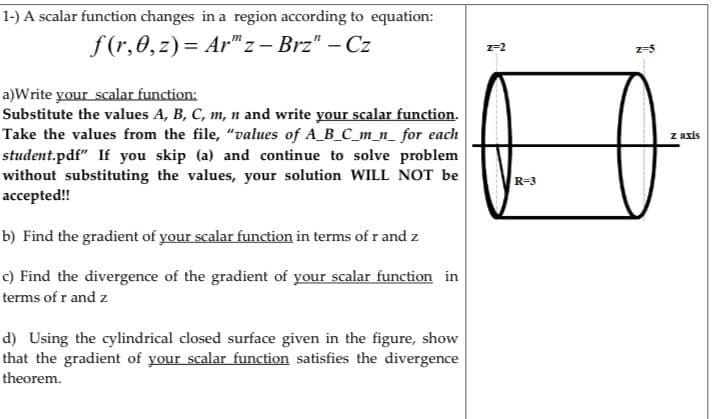1-) A scalar function changes in a region according to equation: f (r,0,z) = Ar"z – Brz" – Cz 2-2 z-5 a)Write your scalar function: Substitute the values A, B, C, m, n and write your scalar function. Take the values from the file, "values of A_B_C_m_n_ for each student.pdf" If you skip (a) and continue to solve problem without substituting the values, your solution WILL NOT be acсepted!! z axis R=3 b) Find the gradient of your scalar function in terms of r and z c) Find the divergence of the gradient of your scalar function in terms of r and z d) Using the cylindrical closed surface given in the figure, show that the gradient of your scalar function satisfies the divergence theorem.
1-) A scalar function changes in a region according to equation: f (r,0,z) = Ar"z – Brz" – Cz 2-2 z-5 a)Write your scalar function: Substitute the values A, B, C, m, n and write your scalar function. Take the values from the file, "values of A_B_C_m_n_ for each student.pdf" If you skip (a) and continue to solve problem without substituting the values, your solution WILL NOT be acсepted!! z axis R=3 b) Find the gradient of your scalar function in terms of r and z c) Find the divergence of the gradient of your scalar function in terms of r and z d) Using the cylindrical closed surface given in the figure, show that the gradient of your scalar function satisfies the divergence theorem.
Algebra & Trigonometry with Analytic Geometry
13th Edition
ISBN:9781133382119
Author:Swokowski
Publisher:Swokowski
Chapter8: Applications Of Trigonometry
Section8.3: Vectors
Problem 60E
Related questions
Question
a=4 b=3 c=6 m=5 n=2

Transcribed Image Text:1-) A scalar function changes in a region according to equation:
f (r,0,z) = Ar"z – Brz" – Cz
2-2
z-5
a)Write your scalar function:
Substitute the values A, B, C, m, n and write your scalar function.
Take the values from the file, "values of A_B_C_m_n_ for each
student.pdf" If you skip (a) and continue to solve problem
without substituting the values, your solution WILL NOT be
аcсepted!!
z axis
R=3
b) Find the gradient of your scalar function in terms of r and z
c) Find the divergence of the gradient of your scalar function in
terms of r and z
d) Using the cylindrical closed surface given in the figure, show
that the gradient of your scalar function satisfies the divergence
theorem.
Expert Solution
This question has been solved!
Explore an expertly crafted, step-by-step solution for a thorough understanding of key concepts.
Step by step
Solved in 4 steps with 4 images

Knowledge Booster
Learn more about
Need a deep-dive on the concept behind this application? Look no further. Learn more about this topic, advanced-math and related others by exploring similar questions and additional content below.Recommended textbooks for you

Algebra & Trigonometry with Analytic Geometry
Algebra
ISBN:
9781133382119
Author:
Swokowski
Publisher:
Cengage

Algebra and Trigonometry (MindTap Course List)
Algebra
ISBN:
9781305071742
Author:
James Stewart, Lothar Redlin, Saleem Watson
Publisher:
Cengage Learning

Algebra & Trigonometry with Analytic Geometry
Algebra
ISBN:
9781133382119
Author:
Swokowski
Publisher:
Cengage

Algebra and Trigonometry (MindTap Course List)
Algebra
ISBN:
9781305071742
Author:
James Stewart, Lothar Redlin, Saleem Watson
Publisher:
Cengage Learning